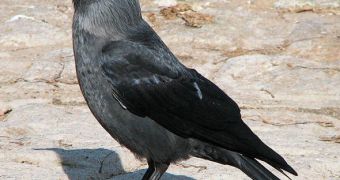Jackdaws, “cousins” of crows and ravens, have been recently proven to be able to understand human-generated cues, such as pointing gestures and eye contact. The find is very important, because it basically puts the relatively-unknown bird on the same level with rhesus monkeys and chimpanzees, in terms of inter-specific communication abilities. In addition to having a brain that can understand what they are trying to tell them, the jackdaws also have human-like eyes, with dark pupils and silvery or deep blue irises.
What's amazing in these birds is that they can understand very subtle eye cues, even some that elude humans at times. For instance, in a cooperation scenario, captive jackdaws became accustomed with a few scientists, who could then enter the cages and give “directions” to the birds. In such an experiment, the researches placed a hidden stash of food out of one bird's field-of-view, and then an investigator started looking into its eyes and then at the food.
Surprisingly, the creature understood what the man was trying to get across, and flew to the place where he was looking. This is a feat of intelligence and perception not exhibited by many animals, despite the fact that some have larger brains than the jackdaws. “I think they can generalize to human eyes somehow, and interpret human eyes as eyes,” University of Oxford cognitive biologist Auguste Bayern told LiveScience. Bayern is also the lead author of a new paper detailing the find, which has been published in the April 2nd online issue of the scientific journal Current Biology.
“If you compare them to apes, our closest relatives, they've got exactly the same brain size relative to body size and weight. As it looks now, apes are surprisingly bad at looking at eyes, because it seems like other cues such as head direction are much more important. But I think they understand a bit,” the expert continued. In addition to understanding eye cues, the birds were also able to comprehend the meaning of hand gestures, when scientists pointed at the location of the food. However, they seemed blind to head gestures and took no action when they saw them.
The only case in which the birds looked at a human head was when a stranger walked into the experiment area. If jackdaws feel a presence they are not accustomed to, they become very attentive to it and, at that time, look closely at the movements of people's heads. Most likely, Bayern added, this was an adaptation to their environment, in that when the birds needed to watch out for predators, it was a lot easier to watch the tilt of the “threat's” head, and then to try and analyze their eye movements from a safe distance.

 14 DAY TRIAL //
14 DAY TRIAL //